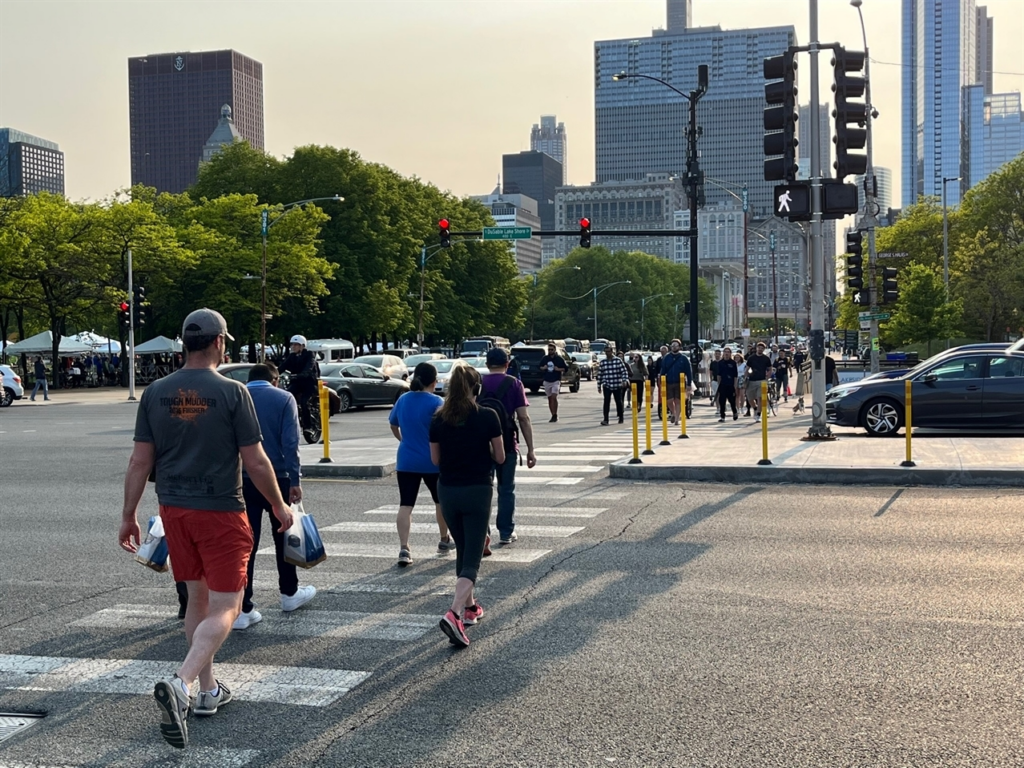A Major Step Toward Improving the Safety of Intersections for Pedestrians and Cyclists

This legislative session we had a major win for traffic safety in Illinois with the passage of SB2278 (Simmons/Buckner), which will ensure that intersection design can be customized to local context and needs.
Currently, local communities are required to build all new intersections to accommodate the turning radius of a 65-foot truck, which often precludes design features that would make intersections safer for people walking and biking. Essentially, the law requires prioritizing trucks over everything else.
Intersections are not only oversized, proven safety features like pedestrian islands, curb extensions, and protected bike lanes are sometimes removed from designs. Huge intersections are unappealing for pedestrians to cross and more dangerous because wide roads invite faster driving, and pedestrians are exposed to traffic longer when crossing.
Current law resulted in the rejection of a proposed pedestrian refuge island on Irving Park Rd. in Chicago (an IDOT-controlled road) to accommodate trucks turning off a local, one-way street, N. Bell Ave. If that refuge island had been built, it might have saved the life of Peter Paquette, who was killed by a motorist while trying to cross the street in June 2022.
SB2278 changes that requirement and allows engineers to design for context. It no longer requires truck turning radius to be the governing design factor. Now that this new legislation is on its way to be signed by Governor Pritzker, engineers will be able to design intersections appropriately for the local context. In the many places that need pedestrian and bicycle safety improvements, we can make them.
So how did we determine the needed legislative fix? In the fall of 2022, MPC convened a group of engineers to interrogate why Illinois has such a poor record of building Complete Streets elements, which was resulting in increasing pedestrian fatality rates. The engineers told us that this truck turning radius requirement was the primary obstacle they faced in designing safe intersections. Therefore, MPC convened discussions including the Chicago Metropolitan Agency for Planning and the Active Transportation Alliance to determine a legislative approach to addressing this issue. We worked with the bill sponsor and tireless traffic safety champion Senator Mike Simmons who worked with additional stakeholders, including the trucking associations and Illinois DOT in final negotiations to develop legislative language that all could agree on.
It was important to us that these safety features are feasible for truckers to navigate. And on that front, this bill is a big win: SB2278 will also require communities to report to IDOT locations that cannot accommodate long trucks. This will result in better information for truckers who can ensure they are taking routes that can physically accommodate their vehicles, which should reduce damage to roadway infrastructure. Trucking industry representatives tell us that this information is an important benefit for them.
The final result: a bill that will save lives. We have never needed it more than now, with bicycle and pedestrian fatalities comprising more than 15 percent of all traffic fatalities in Illinois. In fact, given this worrisome trend, the Federal government is now requiring all states to conduct a Vulnerable User Safety Assessment. As an input to that evaluation, Illinois residents are invited to fill in locations on this map where nonmotorized safety improvements are needed. This can help guide us in defining additional actions needed to improve the safety of cyclists and pedestrians in Illinois.
